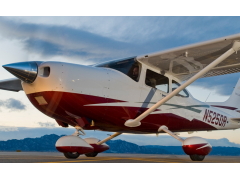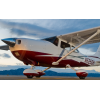exterior
The Cessna Skylane matches powerful capability with a proven airframe that is easy to fly.
The sophisticated Garmin G1000 integrated flight deck combined with a 230 HP high-performance engine gives you performance you can count on. Enjoy room for four with the ergonomically designed two-tone seating and travel over 900 nautical miles nonstop. With the ability to take off and land on short runways, and an impressive payload capability, the Skylane is a true high-performance workhorse.
interior
Classic design and comfort
The leather-appointed seating featuring the sport, two-tone Interior is perfect for both pilots and passengers. Enjoy room for four and cabin accessories including a 12-volt power outlet for your portable electronic devices and advanced cabin air controls.
seating
Deep-contoured leather seats, featuring two-tone interior. With ergonomically designed seats wrapped in durable Luxor or optional leather, the Skylane offers a four-seat configuration, providing room to expand your aviation influence to your friends and colleagues.
avionics
The Cessna Skylane is powered by the latest technology in integrated cockpit avionics, the Garmin G1000 NXi.
With an improved graphical interface, more powerful hardware, higher resolution displays, added functionality to improve situational awareness, and optional wireless technology, managing the flight deck has never been easier.
the most advanced flight deck in the category
The Skylane cockpit features the all-glass Garmin G1000 flight deck customized for Cessna, reducing pilot workload and boosting ease of operation. Two large-format, high-resolution, color liquid crystal displays make fast assimilation of critical flight data effortless. The jet-level GFC 700 autopilot significantly reduces pilot workload and enhances the safety of every flight. Additional features include a go-around button, flight-level change, and precise guidance with optional satellite-driven graphical weather radar.
virtual vision
Synthetic Vision Technology (SVT) enhances visual orientation with three-dimensional renderings of terrain on both flight displays. You’ll feel confident in darkness, haze, rain, fog, or any other IFR conditions that might obstruct a clear view through the windshield. This advanced graphics modeling technology recreates the surrounding landscape accurately in dimensional, graphical renderings on your primary flight display. You’ll get a clear picture of ground and water, airports, obstacles, and air traffic — all shown relative to the aircraft. Never before has risk avoidance been so simple and intuitive. Rising terrain areas or low-altitude flying can sometimes present obstacles that present real danger when unexpected. With SVT, such potential obstacles are rendered and color-coded for alerting when there may be a potential conflict approaching. Towers and other obstacles that may interfere with the flight path are also highlighted and clearly displayed with height-appropriate symbology.
pin-like precision
The Skylane includes a robust flight management system (FMS) with autopilot controls and additional override features to give you the kind of approach precision you would expect in a jet. The CWS button or control-wheel steering momentarily disengages the autopilot and synchronizes the flight director’s command bars with pitch and roll modes. The CWS button is positioned on the top left grip of the pilot’s control wheel. When released, the flight director will recalibrate, establishing new reference points, depending on the current pitch and roll modes. GA switch or go-around button disengages the autopilot, selects flight director go-around mode, and activates a missed approach. It’s conveniently positioned above the throttle on the instrument panel. Additional features are included in this robust system and together they offer Skylane pilots more precision than any other aircraft in the category.
standard features
GMA-1347 Digital Audio Panel with Marker Beacon/Intercom
GTX-33 Transponder-Mode S w-TIS
GIA-63W NAV/COM/GPS/WAAS with GS #1
GIA-63W NAV/COM/GPS/WAAS with GS #2
GDU-1044B Primary Flight Display (PFD)
GDU-1044B Multi-Function Display (MFD)
GEA-71 Engine/Airframe Computer
GRS-77 Attitude & Heading Reference System (AHRS)
GDC-74A Air Data Computer with OAT Probe
GMU-44 Magnetometer
Garmin SafeTaxi & FliteCharts
GFC-700 Autopilot
Go-Around Switch
Electric Trim
A/P Disconnect
Control Wheel Steering Button
Electronic Checklists
ME406 Two Frequency Emergency Locator Transmitter
Emergency Locator Transmitter Remote Mounted Switch
Backup Attitude Gyro, Altimeter and Airspeed Indicator
Control Wheel Push-To-Talk Switch-Pilot/Copilot
Mic & Phone Jacks-Pilot/Copilot/Passengers
Auxiliary Stereo Input Jack
Antennas:
Marker Beacon Antenna
Transponder Antenna
VHF/GPS Antenna (2)
NAV Antenna
Emergency Locator Transmitter External Antenna
Pitot System – Heated
Static System
Hand Held Microphone
Alternate Static Source
Compass
new features and options
Standard ADS-B Out and In
Optional wireless data base and flight plan loading
Integrated VFR Sectional Charts
IFR High and Low Charts with Night Mode
Enhanced HSI features
COM frequency decoding
Vertical Situation Display
Selectable Visual Approaches
Optional Surface Watch for runway safety
Enhanced graphics and faster processing
Improved joystick with smoother panning
Simplified maintenance





